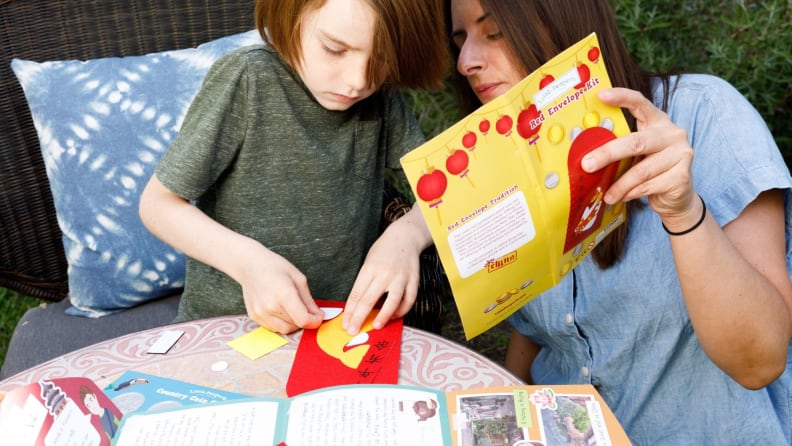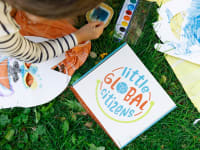This subscription box is a great way to teach kids about the world
Little Passports is world travel in a box
 Credit:
Reviewed / Lisa Lawrence
Credit:
Reviewed / Lisa Lawrence
Products are chosen independently by our editors. Purchases made through our links may earn us a commission.
When we are expecting our son, we had big plans to make him a world traveler. I grew up in an immigrant family where foods and traditions perceived as “exotic” were the norm and pushing yourself outside of our cultural comfort zone was to be expected.
Enter real life, and travel with kids isn’t as simple as we believed it to be in our pre-child wisdom. While we can’t hop on a plane and explore the world as much as we’d like, it’s still important to us to expose our son to other cultures. In a world that feels increasingly closed off and xenophobic, we are always looking for ways to have him learn about other countries and cultures and—like most kids—he’s all in when it comes to learning about the world around him.
When we got the opportunity to review Little Passports, a kids’ subscription that provides world travel in a box, I jumped at the chance to see how we could experience travel, while still hanging out at home.
What is Little Passports?
Founded by two moms, and best friends, Little Passports launched in 2009 with a vision of “inspiring children to learn about the world.” Since then it’s garnered numerous awards by parenting and toy associations.
The founders both had a childhood where they were exposed to different cultures: one spent her childhood living in both the U.S. and Europe and the other grew up in a Chinese-American household. Those experiences inspired them to create a learning experience that teaches kids about geography and culture, while sparking their curiosity and imagination.
When kids first subscribe, they receive a welcome pack, filled with everything they need to embark on their world journey. After that, they receive a kit that focuses on an individual country—24 in all—which arrive each month in an envelope-style package.
If kids (and parents) need a little bit of inspiration to keep the fun and learning going, they can also access plenty of online content, including recipes, science projects, and homeschool ideas through the Little Passports’ blog.
How does Little Passports work?

Your welcome a packet comes in a cute little suitcase. Follow up deliveries arrive in large envelopes filled with surprises.
Little Passports is a subscription-based service. When you sign up, you decide the terms, including which product line you’ll receive, the duration of your subscription, and how often you’ll be charged.
You can opt for a monthly subscription in which you're charged as each shipment is sent, or choose from six- or 12-month prepay options. With each subscription you pay a lower cost per delivery as you increase the duration of your commitment. Subscriptions automatically renew but you can easily cancel at any time by logging into your account.
There are six different subscription options, all with a focus on a global theme. There is Early Explorers, for ages 3 to 5. The World Edition, for ages 6 to 10; a USA edition for ages 7 to 12; a Science Junior subscription for kids 5 to 8; and Science Expedition for kids 8 and older. They also currently offer a Summer Camp in a Box, broken into age brackets for kids ages 3 to 5 or 5 to 8. The summer camp promises a week’s worth of experiments, crafts, STEAM learning, and global discovery.
How much does Little Passports cost?

Kids can collect coins from all 24 countries traveled to.
The cost for a Little Passports subscription depends on a few different factors: which subscription you choose, and whether you sign-up for a monthly membership or one of the multi-month packages. Prices start as low as $23.95 per monthly subscription for the USA edition (which is discounted to as much as $16.95, when you prepay for a year) and go up to $27.95 (or as low as $23.95 with a full-year commitment). The more craft-heavy offerings, like the science subscriptions, tend to cost a bit more.
The subscriptions arrive every month and shipping within the United States is included.
Little Passports also offers an online store where you can purchase “discovery packs," which are their monthly offerings that you can buy out of order without the commitment of a subscription, as well as a gift store filled with supplemental toys, crafts, books, and games.
What is Little Passports like in real life?

It's fun how this subscription motivates kids to get out of their comfort zone.
For this review, we tested the World Edition, for kids 6 to 8. We received three packages: the welcome box, that all subscribers get to start, as well as follow up kits on China and Japan.
The welcome box included everything kids need to be armchair world travelers including a wall-sized world map, travel-inspired stickers galore, a mini play-passport, a display for their soon-to-be foreign toy coin collection, and a cute little “travel case” for kids to store all of their souvenirs after a jet-setting year abroad.
Each month the subscription functions as sort of a care package from your child’s well-traveled older friend or cousin. In the welcome package we got world content, but also content that was Brazil-focused. Each subsequent country arrives in a large envelope, emblazoned with the Little Passports logo and cute global graphics—so it even has the feel of getting some really fun mail from some really cool friends as they travel the world.
Each delivery includes a letter from tween travel guides Sofia and Sam, where they tell all about their favorite parts of the countries they’ve traveled to. The letters include pictures, favorite foods, sight-seeing experiences, and often a little bit of language and trivia. I remember getting letters like this from friends and pen pals growing up and how that piqued my interest in other countries and cultures; you get the feeling that was exactly the aim of Little Passports’ founders.
The packages also include a collectable toy coin, stickers from each country, a map marker (to put on the world map received in the welcome packet), a fold-out activity booklet with games, recipes, and all sorts of info on the country being focused on, and an accompanying activity or craft.
For Brazil, the activity was a mini geology lesson, where kids analyze a piece of amethyst, which was included in the box, along with a mini magnifying glass. For Japan we had an origami activity, for China we had my son’s favorite activity, which was decorating and stitching a hóng bāo (in Mandarin) or lai see (in Cantonese), a traditional red envelope given to children during the Lunar New Year. The crafts arrive with everything you need for the simple activities, as well as curiosity-inspiring information as to why they are symbolic of the countries kids are learning about.
The activity booklets are well-thought out. Each activity focuses on pieces of the country’s culture, from the well-known to the arcane. For example, Brazil’s booklet had Portuguese word searches; China’s had a pictogram activity; and Japan had a haiku game.
Having an offering that spans from ages 6 to 10 left me a bit skeptical, but I can see a range of ages enjoying these packets. That being said, I can’t see the kits appealing on their own to most 10-year-olds I know. My 7-year-old enjoyed these kits, but if you’re contemplating whether this is right for a 10-year-old, I’d recommend looking at their Science Expeditions boxes, which are more complex.
Should you sign up for Little Passports?

We liked that with each activity, we learned a little bit about the history and cultural background info.
If you’re looking for a way to get your kids excited about the world, this is a cute little subscription. My son, who is easily bored, enjoyed the activities and it got him to stop asking if he could play videogames for an hour and asking about the Great Wall of China and giant pandas instead. Mail is always fun, and we really liked the approach of Little Passports, which feels like your child is getting mail from older, cooler kids that appreciate other cultures. Ideally, this will plant the seed to nudge them to aspire to be a bit like Sofia and Sam.
As a parent, I enjoyed the feeling of calm and quiet engagement this box inspires. So many toys and activities for kids seem to wind them up; this afforded us a chill morning where we crafted and talked and where the learning was effortless—a nice respite after a year of being forced to be a teacher (and not a very good one, I should admit).
Unlike other some boxes, there isn’t much continued play with the crafts offered after you make them, but the time spent on creating them and learning about their origins is far more creative and educational than time spent zoning out on a tablet.
While I’m not sure my family will need a full year of Little Passports, my son is asking for more, so we may splurge on a six-month subscription. Sometimes all you need is a little taste of the world to get the global conversation going and inspire a lifelong love of travel. For us, this is a fun way to connect and get inspired for where to travel next, while we save up the money and the vacation time for a real trip.


